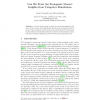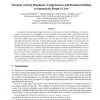524 search results - page 15 / 105 » Disease Modeling Using Evolved Discriminate Function |
FIMH
2007
Springer
14 years 4 months ago
2007
Springer
Abstract. Over the past several decades, the mouse has gained prominence in the cardiac electrophysiology literature as the animal model of choice. Using computer models of the mou...
HUMO
2000
Springer
14 years 1 months ago
2000
Springer
Seeing biological motion is very important for both humans and computers. Psychophysics experiments show that the ability of our visual system for biological motion detection and ...
ICASSP
2011
IEEE
13 years 1 months ago
2011
IEEE
In this paper, the task of selecting the optimal subset of pronunciation variants from a set of automatically generated candidates is recast as a tree search problem. In this appr...
EMNLP
2007
13 years 11 months ago
2007
This paper proposes a framework for semi-supervised structured output learning (SOL), specifically for sequence labeling, based on a hybrid generative and discriminative approach...
DEBU
2006
13 years 9 months ago
2006
Automated reasoning about human behavior is a central goal of artificial intelligence. In order to engage and intervene in a meaningful way, an intelligent system must be able to ...


